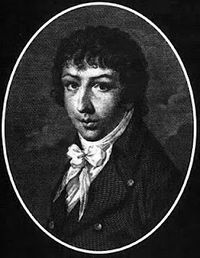Annotation:Haunted Tower: Difference between revisions
No edit summary |
m (Text replacement - "garamond, serif" to "sans-serif") |
||
| (2 intermediate revisions by one other user not shown) | |||
| Line 1: | Line 1: | ||
'''Back to [[{{BASEPAGENAME}}]]''' | '''Back to [[{{BASEPAGENAME}}]]''' | ||
---- | ---- | ||
<p><font face=" | <p><font face="sans-serif" size="4"> | ||
'''HAUNTED TOWER.''' English, Country Dance tune (common time). G Major. Standard tuning (fiddle). AABA. The melody appears in a number of late 18th century and early 19th century collections of tunes and country dances, although it first was published as a country dance in Samuel, Ann and Peter Thompson's '''Twenty Four Country Dances for the Year 1791''' (p. 29). '''The Haunted Tower''' is the name of an opera by English composer Stephen Storace [http://en.wikipedia.org/wiki/Stephen_Storace] (1762-1796), | '''HAUNTED TOWER.''' English, Country Dance tune (common time). G Major. Standard tuning (fiddle). AABA. The melody appears in a number of late 18th century and early 19th century collections of tunes and country dances, although it first was published as a country dance in Samuel, Ann and Peter Thompson's '''Twenty Four Country Dances for the Year 1791''' (p. 29). '''The Haunted Tower''' is the name of an opera by English composer Stephen Storace [http://en.wikipedia.org/wiki/Stephen_Storace] (1762-1796), staged at Drury Lane, London, in 1789, where it sold out for 50 nights in succession. Storace was not only an excellent composer, he had the canniness to tap into the rising vogue for ghost stories, romance, and tales of the supernatural. | ||
[[File:storace.jpg|200px|thumb|left|Stephen Storace]] | [[File:storace.jpg|200px|thumb|left|Stephen Storace]] | ||
<br> | <br> | ||
<br> | <br> | ||
</font></p> | </font></p> | ||
<p><font face=" | <p><font face="sans-serif" size="4"> | ||
''Source for notated version'': | ''Source for notated version'': | ||
<br> | <br> | ||
<br> | <br> | ||
</font></p> | </font></p> | ||
<p><font face=" | <p><font face="sans-serif" size="4"> | ||
''Printed sources'': Wilson ('''Companion to the Ball Room'''), 1816; p. 117. | ''Printed sources'': Wilson ('''Companion to the Ball Room'''), 1816; p. 117. | ||
<br> | <br> | ||
<br> | <br> | ||
</font></p> | </font></p> | ||
<p><font face=" | <p><font face="sans-serif" size="4"> | ||
''Recorded sources'': <font color=teal></font> | ''Recorded sources'': <font color=teal></font> | ||
</font></p> | </font></p> | ||
Latest revision as of 14:22, 6 May 2019
Back to Haunted Tower
HAUNTED TOWER. English, Country Dance tune (common time). G Major. Standard tuning (fiddle). AABA. The melody appears in a number of late 18th century and early 19th century collections of tunes and country dances, although it first was published as a country dance in Samuel, Ann and Peter Thompson's Twenty Four Country Dances for the Year 1791 (p. 29). The Haunted Tower is the name of an opera by English composer Stephen Storace [1] (1762-1796), staged at Drury Lane, London, in 1789, where it sold out for 50 nights in succession. Storace was not only an excellent composer, he had the canniness to tap into the rising vogue for ghost stories, romance, and tales of the supernatural.

Source for notated version:
Printed sources: Wilson (Companion to the Ball Room), 1816; p. 117.
Recorded sources:
Back to Haunted Tower
